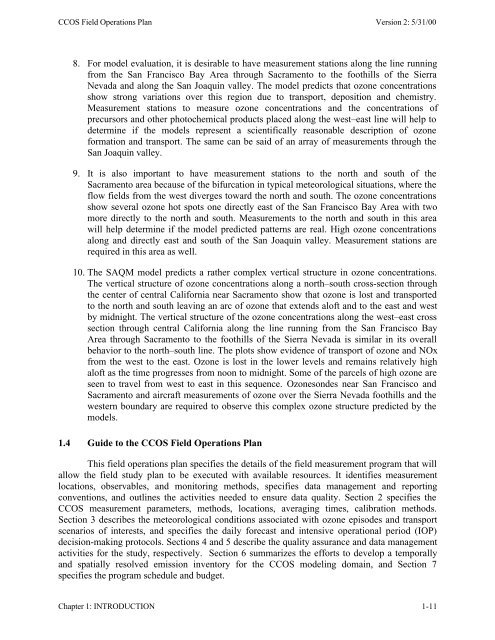Central California Ozone Study (CCOS) - Desert Research Institute
Central California Ozone Study (CCOS) - Desert Research Institute
Central California Ozone Study (CCOS) - Desert Research Institute
You also want an ePaper? Increase the reach of your titles
YUMPU automatically turns print PDFs into web optimized ePapers that Google loves.
<strong>CCOS</strong> Field Operations Plan Version 2: 5/31/00<br />
8. For model evaluation, it is desirable to have measurement stations along the line running<br />
from the San Francisco Bay Area through Sacramento to the foothills of the Sierra<br />
Nevada and along the San Joaquin valley. The model predicts that ozone concentrations<br />
show strong variations over this region due to transport, deposition and chemistry.<br />
Measurement stations to measure ozone concentrations and the concentrations of<br />
precursors and other photochemical products placed along the west–east line will help to<br />
determine if the models represent a scientifically reasonable description of ozone<br />
formation and transport. The same can be said of an array of measurements through the<br />
San Joaquin valley.<br />
9. It is also important to have measurement stations to the north and south of the<br />
Sacramento area because of the bifurcation in typical meteorological situations, where the<br />
flow fields from the west diverges toward the north and south. The ozone concentrations<br />
show several ozone hot spots one directly east of the San Francisco Bay Area with two<br />
more directly to the north and south. Measurements to the north and south in this area<br />
will help determine if the model predicted patterns are real. High ozone concentrations<br />
along and directly east and south of the San Joaquin valley. Measurement stations are<br />
required in this area as well.<br />
10. The SAQM model predicts a rather complex vertical structure in ozone concentrations.<br />
The vertical structure of ozone concentrations along a north–south cross-section through<br />
the center of central <strong>California</strong> near Sacramento show that ozone is lost and transported<br />
to the north and south leaving an arc of ozone that extends aloft and to the east and west<br />
by midnight. The vertical structure of the ozone concentrations along the west–east cross<br />
section through central <strong>California</strong> along the line running from the San Francisco Bay<br />
Area through Sacramento to the foothills of the Sierra Nevada is similar in its overall<br />
behavior to the north–south line. The plots show evidence of transport of ozone and NOx<br />
from the west to the east. <strong>Ozone</strong> is lost in the lower levels and remains relatively high<br />
aloft as the time progresses from noon to midnight. Some of the parcels of high ozone are<br />
seen to travel from west to east in this sequence. <strong>Ozone</strong>sondes near San Francisco and<br />
Sacramento and aircraft measurements of ozone over the Sierra Nevada foothills and the<br />
western boundary are required to observe this complex ozone structure predicted by the<br />
models.<br />
1.4 Guide to the <strong>CCOS</strong> Field Operations Plan<br />
This field operations plan specifies the details of the field measurement program that will<br />
allow the field study plan to be executed with available resources. It identifies measurement<br />
locations, observables, and monitoring methods, specifies data management and reporting<br />
conventions, and outlines the activities needed to ensure data quality. Section 2 specifies the<br />
<strong>CCOS</strong> measurement parameters, methods, locations, averaging times, calibration methods.<br />
Section 3 describes the meteorological conditions associated with ozone episodes and transport<br />
scenarios of interests, and specifies the daily forecast and intensive operational period (IOP)<br />
decision-making protocols. Sections 4 and 5 describe the quality assurance and data management<br />
activities for the study, respectively. Section 6 summarizes the efforts to develop a temporally<br />
and spatially resolved emission inventory for the <strong>CCOS</strong> modeling domain, and Section 7<br />
specifies the program schedule and budget.<br />
Chapter 1: INTRODUCTION 1-11
















